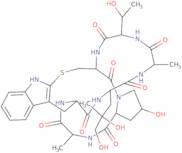
Phalloidin
CAS: 17466-45-4
Ref. 3D-FP72056
| 1mg | To inquire | ||
| 2mg | To inquire | ||
| 5mg | To inquire | ||
| 10mg | To inquire | ||
| 500µg | To inquire |
Product Information
- Phalloidin, Amanita phalloides
- 29-(2,3-dihydroxy-2-methylpropyl)-2-hydroxy-23-(1-hydroxyethyl)-6,26-dimethyl-1,2,3,3a,5,6,8,9,10,15-decahydro-17H-18,9-(epiminoethanoiminoethanoiminoethanoiminomethano)pyrrolo[1',2':5,6][1,5,8,11]thiatriazacyclopentadecino[15,14-b]indole-4,7,19,22,25,28,31(18H)-heptone
- (2S,3aS,6S,9S,18R,23R,26S,29S)-29-[(2R)-2,3-dihydroxy-2-methylpropyl]-2-hydroxy-23-[(1S)-1-hydroxyethyl]-6,26-dimethyl-1,2,3,3a,5,6,8,9,10,15-decahydro-17H-18,9-(epiminoethanoiminoethanoiminoethanoiminomethano)pyrrolo[1',2':5,6][1,5,8,11]thiatriazacyclopentadecino[15,14-b]indole-4,7,19,22,25,28,31(18H)-heptone
Phalloidin is a cell-permeable, cationic fluorescent dye that binds to the cytoskeletal protein actin and stains nuclei in cells. It has been used as a marker for the identification of cell nuclei or in biological studies of kidney fibrosis. Phalloidin has also been shown to be effective against matrix effect in cultured cells. The rate constant for phalloidin binding to actin is dependent on the pH of the solution, with higher concentrations found at lower pH values. The chemical structure of phalloidin consists of three components: a benzene ring, an amino group and a carboxyl group. When phalloidin is exposed to cytochalasin B, p2y receptors are inhibited and this inhibits enzyme activities such as adenylate cyclase activity and phospholipase activity. This inhibition can lead to toxicological effects on cells such as apoptosis induction or necrosis induction.
Chemical properties
Technical inquiry about: 3D-FP72056 Phalloidin
If you want to request a quotation or place an order, please instead add the desired products to your cart and then request a quotation or order from the cart. It is faster, cheaper, and you will be able to benefit from the available discounts and other advantages.





